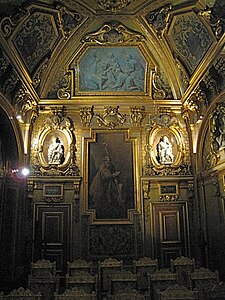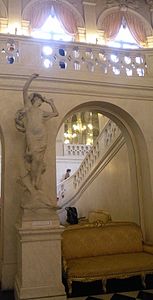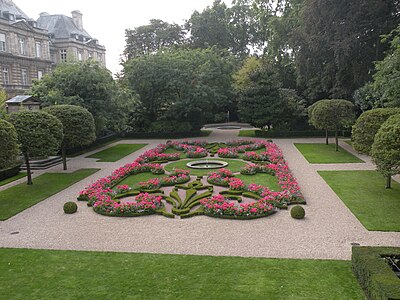Petit Luxembourg
| Petit Luxembourg | |
|---|---|
French Senate | |
| Construction started | c. 1550 |
| Renovated | 1710–1713 |
| Design and construction | |
| Architect(s) |
|
The Petit Luxembourg (pronounced
Early history
The original sixteenth-century building is of obscure origin,
-
Perspective view
-
Floor plan with some later modifications made by Marie de Médicis
In 1627 Marie de Médicis gave the Petit Luxembourg to
Boffrand's alterations

Boffrand demolished the service buildings to the west of the courtyard, replacing them with a new wing for the
Although Boffrand preserved the façades of the older wing, he completely redesigned the interior. A modest
In large rooms, such as the stair hall and the Grand Salon, Boffrand's unit of design was not the wall (as seen with
Boffrand also added another hôtel for the household, with kitchens and stables, on the other side of rue de Vaugirard; an underground passage linked the two residences.
-
Boffrand's staircase
-
Grand Salon
-
Project of 1709, first-floor plans for the main buildings (south at the top)
-
Project of 1709, ground-floor plans for the main buildings and the service wing north of the rue de Vaugirard[5]
-
Coach entrance on the rue de Vaugirard from Boffrand's Livre d'architecture, 1745[6]
Later history
During the French Revolution, from
Under Napoleon, the
Images of the Petit Luxembourg
-
Courtyard side of the entrance
-
Winter garden
-
Chapel (1622–1631)
-
Grand staircase, reflected in a mirror
-
Stair hall ceiling with 1894 painting by Hippolyte Berteaux
-
Installation of theCouder, 1856[7]
-
Napoleonic marble plaque inserted in 18th-centuryboiserie
-
Office of the Senate President
-
Garden fountain, 1905
-
Garden
Notes
- ^ a b c d e Ayers 2004, p. 132.
- ^ Ochterbeck 2009, p. 202.
- ^ a b c Le « Petit Luxembourg » at the French Senate website.
- ^ a b Kalnein 1995, p. 61.
- ^ The north service wing (with kitchens and stables) was demolished after 1909, since it is shown on a 1910 map (Hustin 1910, p. XXIV).
- ^ Boffrand 1745, plate XLV.
- ^ "Bicentenaire du Sénat : Conseil d'État" at the French Senate website.
Bibliography
- Ayers, Andrew (2004). The Architecture of Paris. Stuttgart; London: Edition Axel Menges. ISBN 9783930698967.
- Boffrand, Germain (1745). Livre d'architecture. Paris. Copy at INHA
- Hustin, Arthur (1910). Le Luxembourg, son histoire domaniale, architecturale, décorative et anecdotique. Des premiers siècles à l'année 1611. Paris: Imprimérie du Sénat. .
- Kalnein, Wend von (1995). Architecture in France in the Eighteenth Century. New Haven: Yale University Press. ISBN 9780300060133.
- Ochterbeck, Cynthia Clayton, editor (2009). The Green Guide Paris. Greenville, South Carolina: Michelin Maps and Guides. ISBN 9781906261375.
External links
- "The Petit Luxembourg" at the website of the French Senate






![Project of 1709, ground-floor plans for the main buildings and the service wing north of the rue de Vaugirard[5]](http://upload.wikimedia.org/wikipedia/commons/thumb/8/8d/Plan_du_rez-de-chauss%C3%A9e_du_Petit_Luxembourg_avec_basse-cour%2C_1709_project_-_Gallica_2011-09_%28adjusted%29.jpg/257px-Plan_du_rez-de-chauss%C3%A9e_du_Petit_Luxembourg_avec_basse-cour%2C_1709_project_-_Gallica_2011-09_%28adjusted%29.jpg)
![Coach entrance on the rue de Vaugirard from Boffrand's Livre d'architecture, 1745[6]](http://upload.wikimedia.org/wikipedia/commons/thumb/d/d6/Porte_du_Palais_du_petit_Luxembourg_Pl45_Livre_d%27architecture_par_G_Boffrand_-_INHA_%28cropped%29.jpg/495px-Porte_du_Palais_du_petit_Luxembourg_Pl45_Livre_d%27architecture_par_G_Boffrand_-_INHA_%28cropped%29.jpg)





![Installation of the Conseil d'Etat at the Petit Luxembourg, 25 December 1799, by Couder, 1856[7]](http://upload.wikimedia.org/wikipedia/commons/thumb/8/8a/Couder_-_Installation_du_Conseil_d%27Etat.png/282px-Couder_-_Installation_du_Conseil_d%27Etat.png)



